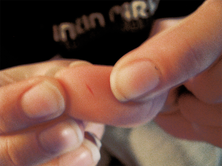|
Your knees are not supposed to ache nor should they make a popping noise when you squat or go up stairs. If you are experiencing these symptoms, it is likely due to decreased strength or mobility of the hip and ankle causing poor tracking of the kneecap. In a recent knee pain post, I demonstrated two great exercises for individuals experiencing knee pain- repeated calf mobility and hip extension planks. In my new video below, watch me perform a quick-knee evaluation. At Heafner Health, we use a combination of hands-on techniques, including soft tissues tools and joint manipulation, as well as home exercises to make you healthy as quickly as possible.
To schedule an appointment or learn more information, visit HeafnerHealth.com
2 Comments
If you are a runner, there is a high probability you have experienced knee pain at some point during your career. As I mentioned in Part I of this post, your knees undergo 2-3x your body weight with each step while running. Due to these high compressive forces, if your running mechanics are not perfect, your body will breakdown somewhere. Runners need to exhibit good lower abdominal strength, good hip mobility and stability, and adequate ankle dorsiflexion (calf mobility). In Part II of this video post, you will learn 2-easy self treatment strategies to fix your knee pain while running. Do you need a routine of necessary corrective exercises specific to your sport or activity? Schedule a whole body corrective exercises appointment with Heafner Health. If you are experiencing pain, call us today to see if you are appropriate for Physical Therapy.
P: 618-604-3293 E: [email protected]  There is no better way to start your weekend, than getting on a trail early in the morning for a run. The sun faintly shining through the trees, the dew still settling on the ground, and a chill in the air. The perfect image for a trail runner...until you take your first steps and your knee pain reminds you something is not perfect. As you warm-up, the pain is a dull ache. You can almost convince yourself it is not present. Unfortunately, after 10 minutes of running, the dull ache has turned into a sharp, anterior knee pain. The sensation of swelling is present and the knee doesn't feel strong. Ultimately, you push through the run. The thoughts of the damage done to your knee linger in your conscious. Humans are meant to be runners, but why are so many runners having knee pain?  The problem is not with the action of running. The problem is with one's biomechanics as they run. There is a big difference. Running places 2-3x your body weight across the knee joints with each step. The repetitive compressive forces causes microtrauma if one's running form, shoe style, mobility, and stability are compromised. Running requires proper trunk stability and good distal mobility. One must exhibit good lower abdominal strength, hip control, and proper ankle mobility. A combination of prolonged sitting, improper diet, and lack of full range of motion exploration hinders us. Knees are predisposed to injury due to thier location on the body. The knee is a modified hinge joint with motion in a single plane limiting the ability to absorb abnormal stresses.  Since the knee only moves in one plane, the position of the hip and ankle have a profound affect on the forces that meet at the knee. We challenge the hip and ankle in our activities, allowing them to become stiff. This requires us to stretch and loosen the joints to remain healthy and pain-free. When we don’t attend to the demands on the hip and ankle, the detriments often appear in the knee. If motion is lacking above or below the knee, the abnormal forces dispersed on the inherently unstable knee will result in pain. The treatment for knee pain from running is multifold. Addressing the mobility of the hips and ankle as well as addressing core strength and specific running form is crucial. For a full functional movement evaluation or physical therapy services, contact Heafner Health directly. Trail running season is quickly approaching! Make sure you have the knees for that perfect run.  Jim Heafner PT, DPT, OCS, Jim earned his Doctorate of Physical Therapy from Saint Louis University. He is a certified Orthopedic Clinical Specialist and trained in the Selective Functional Movement Assessment (SFMA) and Functional Movement Screening (FMS) systems. His educational and clinical background have made him an expert in manual and manipulative physical therapy as well as functional movement. When Jim is not treating patients in the clinic, he focuses his attention on educating fellow physical therapists in the profession, teaching manual therapy courses in Arizona. In addition, his physical therapy based blog attracts upwards of 65,000 views per week. As a physical therapist, I treat pain. Actually, I treat the cause of one's pain. Pain can be classified as acute or chronic depending on the duration of one's symptoms. Acute pain begins suddenly. It is often described as sharp and usually results from a specific injury. Examples of acute pain include post-surgery, a paper cut, or a sports injury. Chronic pain can be defined as pain lasting greater than 3 months and is often described as dull, nagging, or achy. Chronic pain is vastly different and much more complex than acute pain. In chronic pain, the tissue that was originally damaged has healed. For various reasons, pain signals remain active in the region giving the perception of pain. When thinking about chronic pain, I always picture that one eccentric aunt, who is always talking about her pain at family parties. Her pain never seems to go away, and she is always trying some 'new treatment' to cure it. She defines herself by the pain. What is interesting about pain, is that the severity of the injury does not match the intensity of pain. For example, a paper cut can cause immediate, intense pain, versus a broken bone may go unnoticed. In 2013, when Louisville basketball player Kevin Ware sustained a horrific leg fracture, he reported, "it was one of those things where I couldn't believe it. I honestly didn't feel the pain. It was more a shock." The perception of pain and the context of the injury matters significantly. A variety of treatments exist for both acute and chronic pain. Acute pain is best managed with rest, ice, compression, elevation, and protecting the site of injury. Chronic pain is more difficult to treat. It requires a special treatment plan focused on education, aerobic activity, and reprogramming the nervous system (see the video below). Take home message: Both acute and chronic pain is real, but one's perception of the pain will alter the response to it. Physical therapy has been shown to be effective in resolving both types of pain. The video drawing above is a simple and accurate representation of how and why pain occurs. I have given this to many patients to help them understand why they are having pain. To learn more about your pain, contact Heafner Health to learn more information or schedule an appointment.
P: 618-604-3293 E: [email protected] -Jim Heafner PT, DPT, OCS |
Heafner HealthPhysical Therapy Archives
April 2024
Categories |






 RSS Feed
RSS Feed
